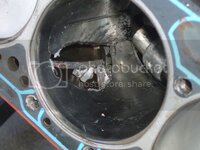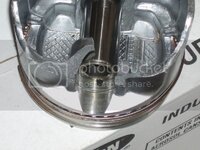73 Mike
I'll drive it someday
As some of you may remember, I had a minor mishap with a nice stroker engine that I was running.

The piston in that cylinder is now in a display jar in my office. The single largest piece is probably 1/24th of the total piston so there isn't much to give a good indication of what went wrong.
I now have a replacement block at the machine shop and I'm starting to get the other components ready. Though they look good, I don't plan to reuse the piston pins but needed them out to remove the rods, which I will be reusing. I knew that the piston in this cylinder had a small crack where the retaining clip was attached, but when I gently nudged the pin with a hammer, this is what I saw:


Since it doesn't look like the clip came out and then the piston was damaged, does the fracture at the base of the piston give any hints about what went wrong? I always attributed the piston failure to detonation. Now I'm not so sure as this piston looks like new on the crown. No visible cracks either other than the on shown.
I'm very concerned about making the same mistake twice.

The piston in that cylinder is now in a display jar in my office. The single largest piece is probably 1/24th of the total piston so there isn't much to give a good indication of what went wrong.
I now have a replacement block at the machine shop and I'm starting to get the other components ready. Though they look good, I don't plan to reuse the piston pins but needed them out to remove the rods, which I will be reusing. I knew that the piston in this cylinder had a small crack where the retaining clip was attached, but when I gently nudged the pin with a hammer, this is what I saw:


Since it doesn't look like the clip came out and then the piston was damaged, does the fracture at the base of the piston give any hints about what went wrong? I always attributed the piston failure to detonation. Now I'm not so sure as this piston looks like new on the crown. No visible cracks either other than the on shown.
I'm very concerned about making the same mistake twice.
Last edited:

